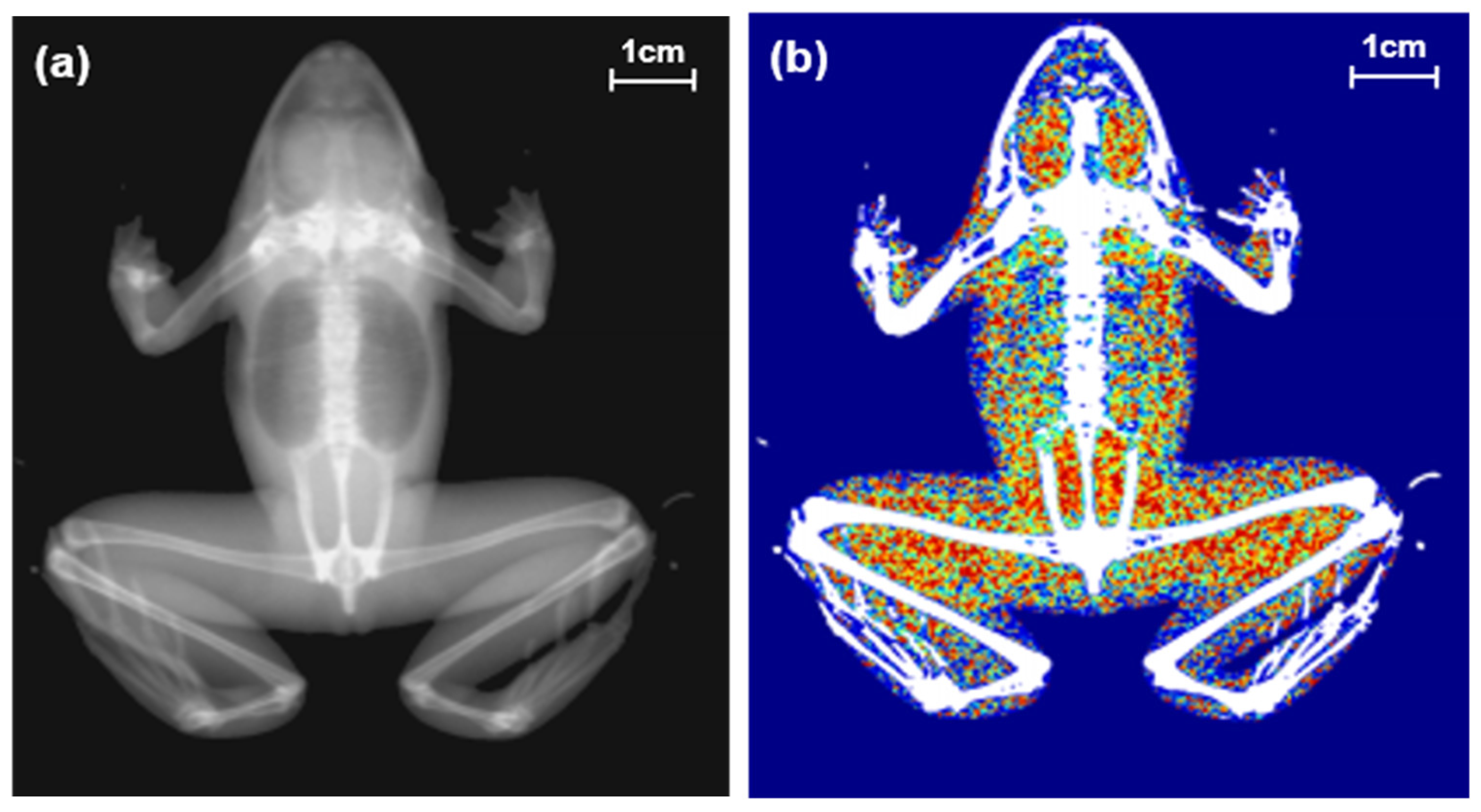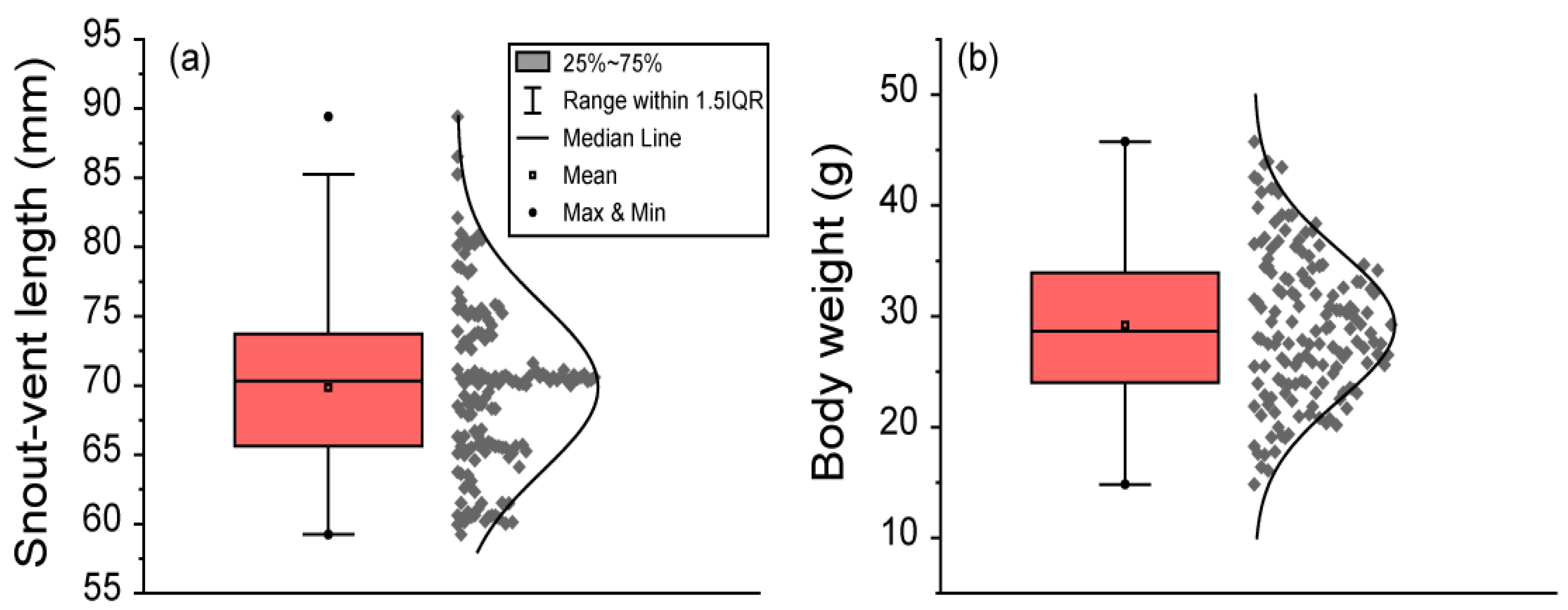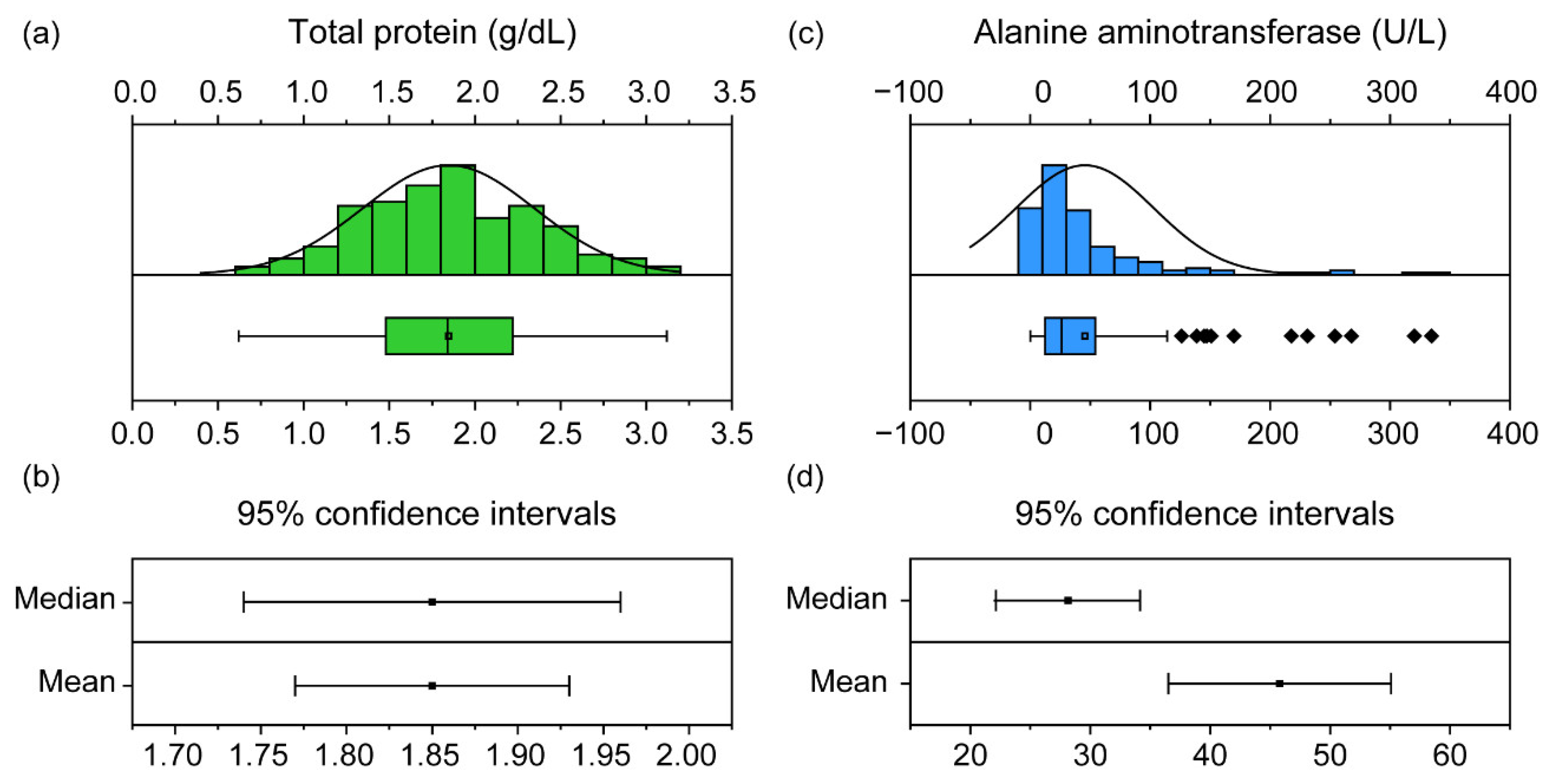Reference Intervals in Combined Veterinary Clinical Examinations of Male Black-Spotted Pond Frogs (Pelophylax nigromaculatus)
Abstract
Simple Summary
Abstract
1. Introduction
2. Materials and Methods
2.1. Animals
2.2. Immune Assay
2.3. Measurements of Body Composition and Bone Mineral Density
2.4. Serum Chemistry Analysis
2.5. Statistical Analysis
3. Results
3.1. The Basic Physical Information from 151 Male Frogs
3.2. Reference Interval of Immunity, Body Composition, and BMD
3.3. Reference Interval of Blood Serum Components
4. Discussion
5. Conclusions
Supplementary Materials
Author Contributions
Funding
Institutional Review Board Statement
Data Availability Statement
Conflicts of Interest
References
- Wikelski, M.; Cooke, S.J. Conservation physiology. Trends Ecol. Evol. 2006, 21, 38–46. [Google Scholar] [CrossRef] [PubMed]
- Radostits, O.M.; Mayhew, I.G.; Houston, D.M. Veterinary Clinical Examination and Diagnosis; W.B. Saunders: Philadelphia, PA, USA, 2000. [Google Scholar]
- Kelly, W.R. Veterinary Clinical Diagnosis; Bailliere Tindall: London, UK, 1977; pp. 271–282. [Google Scholar]
- Kerr, M.G. Veterinary Laboratory Medicine: Clinical Biochemistry and Haematology; John Wiley & Sons: Hoboken, NJ, USA, 2008. [Google Scholar]
- Thrall, D.E. Textbook of Veterinary Diagnostic Radiology, 7th ed.; Elsevier Health Sciences: Amsterdam, The Netherlands, 2017. [Google Scholar]
- Kaneko, J.J.; Harvey, J.W.; Bruss, M.L. Clinical Biochemistry of Domestic Animals. In Clinical Biochemistry of Domestic Animals; Academic Press: San Diego, CA, USA, 2008. [Google Scholar]
- Liebl, A.L.; Martin, L.B., II. Simple quantification of blood and plasma antimicrobial capacity using spectrophotometry. Funct. Ecol. 2009, 23, 1091–1096. [Google Scholar] [CrossRef]
- Strobel, S.; Becker, N.I.; Encarnação, J.A. No short-term effect of handling and capture stress on immune responses of bats assessed by bacterial killing assay. Mamm. Biol. 2015, 80, 312–315. [Google Scholar] [CrossRef]
- Matson, K.D.; Tieleman, B.I.; Klasing, K.C. Capture Stress and the Bactericidal Competence of Blood and Plasma in Five Species of Tropical Birds. Physiol. Biochem. Zoöl. 2006, 79, 556–564. [Google Scholar] [CrossRef]
- Titon, S.C.M.; Junior, B.T.; Assis, V.R.; Kinker, G.S.; Fernandes, P.A.C.M.; Gomes, F.R. Interplay among steroids, body condition and immunity in response to long-term captivity in toads. Sci. Rep. 2018, 8, 17168. [Google Scholar] [CrossRef] [PubMed]
- Venesky, M.D.; Wilcoxen, T.E.; Rensel, M.A.; Rollins-Smith, L.; Kerby, J.L.; Parris, M.J. Dietary protein restriction impairs growth, immunity, and disease resistance in southern leopard frog tadpoles. Oecologia 2011, 169, 23–31. [Google Scholar] [CrossRef] [PubMed]
- Demas, G.E.; Zysling, D.A.; Beechler, B.R.; Muehlenbein, M.P.; French, S.S. Beyond phytohaemagglutinin: Assessing vertebrate immune function across ecological contexts. J. Anim. Ecol. 2011, 80, 710–730. [Google Scholar] [CrossRef] [PubMed]
- Homyack, J.A. Evaluating habitat quality of vertebrates using conservation physiology tools. Wildl. Res. 2010, 37, 332–342. [Google Scholar] [CrossRef]
- Cataldi, E.; Di Marco, P.; Mandich, A.; Cataudella, S. Serum parameters of Adriatic sturgeon Acipenser naccarii (Pisces: Acipenseriformes): Effects of temperature and stress. Comp. Biochem. Physiol. Part A Mol. Integr. Physiol. 1998, 121, 351–354. [Google Scholar] [CrossRef]
- Park, J.-K.; Do, Y. Physiological Response of Pelophylax nigromaculatus Adults to Salinity Exposure. Animals 2020, 10, 1698. [Google Scholar] [CrossRef]
- Divers, S.J.; Cooper, J.E. Reptile hepatic lipidosis. Semin. Avian Exot. Pet Med. 2000, 9, 153–164. [Google Scholar] [CrossRef]
- Zotti, A.; Selleri, P.; Carnier, P.; Morgante, M.; Dvm, D.B. Relationship between metabolic bone disease and bone mineral density measured by dual-energy X-ray absorptiometry in the green iguana (Iguana iguana). Veter Radiol. Ultrasound 2004, 45, 10–16. [Google Scholar] [CrossRef]
- Park, J.K.; Do, Y. Assessment of Body Condition in Amphibians Using Radiography: Relationship between Bone Mineral Density and Food Resource Availability. Korean J. Ecol. Environ. 2019, 52, 358–365. [Google Scholar] [CrossRef]
- Hellbach, K.; Yaroshenko, A.; Willer, K.; Pritzke, T.; Baumann, A.; Hesse, N.; Auweter, S.; Reiser, M.F.; Eickelberg, O.; Pfeiffer, F.; et al. Facilitated Diagnosis of Pneumothoraces in Newborn Mice Using X-ray Dark-Field Radiography. Investig. Radiol. 2016, 51, 597–601. [Google Scholar] [CrossRef]
- Krautwald-Junghanns, M.-E.; Zebisch, K.; Enders, F.; Pees, M.; Willuhn, J. Diagnosis of liver disease in birds by radiography and ultrasonography: Under special consideration of ultrasound-guided liver biopsies. Semin. Avian Exot. Pet Med. 2001, 10, 153–161. [Google Scholar] [CrossRef]
- Stuart, S.N.; Chanson, J.S.; Cox, N.A.; Young, B.E.; Rodrigues, A.S.L.; Fischman, D.L.; Waller, R.W. Status and Trends of Amphibian Declines and Extinctions Worldwide. Science 2004, 306, 1783–1786. [Google Scholar] [CrossRef] [PubMed]
- Navas, C.A.; Otani, L. Physiology, environmental change, and anuran conservation. Phyllomedusa J. Herpetol. 2007, 6, 83. [Google Scholar] [CrossRef]
- Pessier, A.P.; Baitchman, E.J.; Crump, P.; Wilson, B.; Griffith, E.; Ross, H. Causes of mortality in anuran amphibians from an ex- situ survival assurance colony in Panama. Zoo Biol. 2014, 33, 516–526. [Google Scholar] [CrossRef] [PubMed]
- Allender, M.C.; Fry, M.M. Amphibian Hematology. Veter Clin. N. Am. Exot. Anim. Pr. 2008, 11, 463–480. [Google Scholar] [CrossRef]
- Gomez-Mestre, I.; Tejedo, M.; Ramayo, E.; Estepa, J. Developmental Alterations and Osmoregulatory Physiology of a Larval Anuran under Osmotic Stress. Physiol. Biochem. Zoöl. 2004, 77, 267–274. [Google Scholar] [CrossRef]
- Solís, M.E.; Bandeff, J.M.; Huang, Y. Hematology and serum chemistry of ozark and eastern hellbenders (Cryptobranchus alleganiensis). Herpetologica 2007, 63, 285–292. [Google Scholar] [CrossRef]
- Park, J.-K.; Do, Y. Evaluating the physical condition of Hyla japonica using radiographic techniques. Sci. Total. Environ. 2020, 726, 138596. [Google Scholar] [CrossRef] [PubMed]
- Jones, G.R.; Haeckel, R.; Loh, T.P.; Sikaris, K.; Streichert, T.; Katayev, A.; Barth, J.H.; Ozarda, Y. Indirect methods for reference interval determination – review and recommendations. Clin. Chem. Lab. Med. 2018, 57, 20–29. [Google Scholar] [CrossRef]
- Farver, T.B. Concepts of Normality in Clinical Biochemistry. In Clinical Biochemistry of Domestic Animals; Elsevier BV: Amsterdam, The Netherlands, 1997; pp. 1–19. [Google Scholar]
- AmphibiaWeb. Pelophylax nigromaculatus: Dark-Spotted Frog. Available online: http://amphibiaweb.org/species/5109 (accessed on 14 March 2021).
- Gong, J.; Lan, H.; Fang, S.-G.; Wan, Q.-H. Development and characterization of 13 polymorphic microsatellite DNA markers for the pond green frog (Rana nigromaculata). J. Genet. 2010, 92, 7–10. [Google Scholar] [CrossRef]
- Friedrichs, K.R.; Harr, K.E.; Freeman, K.P.; Szladovits, B.; Walton, R.M.; Barnhart, K.F.; Blanco-Chavez, J. ASVCP reference interval guidelines: Determination of de novo reference intervals in veterinary species and other related topics. Veter Clin. Pathol. 2012, 41, 441–453. [Google Scholar] [CrossRef] [PubMed]
- Medler, S. Anesthetic MS-222 eliminates nerve and muscle activity in frogs used for physiology teaching laboratories. Adv. Physiol. Educ. 2019, 43, 69–75. [Google Scholar] [CrossRef]
- Lillywhite, H.B.; Shine, R.; Jacobson, E.; DeNardo, D.F.; Gordon, M.S.; Navas, C.A.; Wang, T.; Seymour, R.S.; Storey, K.B.; Heatwole, H.; et al. Anesthesia and Euthanasia of Amphibians and Reptiles Used in Scientific Research: Should Hypothermia and Freezing Be Prohibited? Bioscience 2017, 67, 53–61. [Google Scholar] [CrossRef]
- De Assis, V.R.; Titon, S.C.M.; Barsotti, A.M.G.; Spira, B.; Gomes, F.R. Antimicrobial Capacity of Plasma from Anurans of the Atlantic Forest. South Am. J. Herpetol. 2013, 8, 155–160. [Google Scholar] [CrossRef]
- McWilliams, D.A. Nutrition recommendations for some captive amphibian species (Anura and Caudata). Can. Assoc. Zoo Aquariums Nutr. Advis. Res. Group 2008, 7–10. [Google Scholar]
- Costanzo, J.P.; Lee, R.E.; Lortz, P.H. Glucose concentration regulates freeze tolerance in the wood frog Rana sylvatica. J. Exp. Biol. 1993, 181, 245–255. [Google Scholar] [CrossRef]
- Salazar, J.H. Overview of urea and creatinine. Lab. Med. 2014, 45, e19–e20. [Google Scholar] [CrossRef]
- Casey, A.; Greenhaff, P.L. Does dietary creatine supplementation play a role in skeletal muscle metabolism and performance? Am. J. Clin. Nutr. 2000, 72, 607S–617S. [Google Scholar] [CrossRef]
- Wyss, M.; Kaddurah-Daouk, R. Creatine and Creatinine Metabolism. Physiol. Rev. 2000, 80, 1107–1213. [Google Scholar] [CrossRef] [PubMed]
- Wright, K.M.; Whitaker, B.R. Amphibian Medicine and Captive Husbandry; Krieger Publishing Company: Malabar, FL, USA, 2001. [Google Scholar]
- Wilson, S.; Felt, S.; Torreilles, S.; Howard, A.; Behan, C.; Moorhead, R.; Green, S. Serum Clinical Biochemical and Hematologic Reference Ranges of Laboratory-Reared and Wild-Caught Xenopus laevis. J. Am. Assoc. Lab. Anim. Sci. 2011, 50, 635–640. [Google Scholar] [PubMed]
- Cathers, T.; A Lewbart, G.; Correa, M.; Stevens, J.B. Serum chemistry and hematology values for anesthetized American bullfrogs (Rana catesbeiana). J. Zoo Wildl. Med. 1997, 28, 171–174. [Google Scholar] [PubMed]
- Young, S.; Warner, J.; Skerratt, L.F.; Speare, R.; Berger, L.; Muller, R. Hematologic and plasma biochemical reference intervals for health monitoring of wild Australian tree frogs. Veter Clin. Pathol. 2012, 41, 478–492. [Google Scholar] [CrossRef]
- Chang, A.G.; Hu, J.; Lake, E.; Bouley, N.M.; Johns, J.L. Biochemical and Hematologic Reference Intervals for Aged Xenopus laevis in a Research Colony. J. Am. Assoc. Lab. Anim. Sci. 2015, 54, 465–470. [Google Scholar] [PubMed]
- Forzán, M.J.; Heatley, J.; Russell, K.E.; Horney, B. Clinical pathology of amphibians: A review. Veter Clin. Pathol. 2017, 46, 11–33. [Google Scholar] [CrossRef] [PubMed]
- Heatley, J.J.; Johnson, M. Clinical technique: Amphibian hematology: A practitioner’s guide. J. Exot. Pet Med. 2009, 18, 14–19. [Google Scholar] [CrossRef]
- Elmberg, J. Factors affecting male yearly mating success in the common frog, Rana temporaria. Behav. Ecol. Sociobiol. 1991, 28, 125–131. [Google Scholar] [CrossRef]
- King, J.D.; Muhlbauer, M.C.; James, A. Radiographic diagnosis of metabolic bone disease in captive bred mountain chicken frogs (Leptodactylus fallax). Zoo Biol. 2010, 30, 254–259. [Google Scholar] [CrossRef]
- Martini, F.; Sell, S.; Kremling, E.; Küsswetter, W. Determination of periprosthetic bone density with the DEXA method after implantation of custom-made uncemented femoral stems. Int. Orthop. 1996, 20, 218–221. [Google Scholar] [CrossRef]
- Hopton, M.E.; Cameron, G.N.; Cramer, M.J.; Polak, M.; Uetz, G.W.; Hopton, M. Live animal radiography to measure developmental instability in populations of small mammals after a natural disaster. Ecol. Indic. 2009, 9, 883–891. [Google Scholar] [CrossRef]
- Bentley, P. Calcium metabolism in the Amphibia. Comp. Biochem. Physiol. Part A Physiol. 1984, 79, 1–5. [Google Scholar] [CrossRef]
- Underwood, W.; Anthony, R.; Gwaltney-Brant, S.; Poison, A.; Meyer, R. AVMA Guidelines for the Euthanasia of Animals; American Veterinary Medical Association: Schaumburg, IL, USA, 2020. [Google Scholar]
- Keifer, J.; Zheng, Z. Cold block of in vitro eyeblink reflexes: Evidence supporting the use of hypothermia as an anesthetic in pond turtles. J. Exp. Biol. 2017, 220, 4370–4373. [Google Scholar] [CrossRef] [PubMed]
- Shine, R.; Amiel, J.; Munn, A.J.; Stewart, M.; Vyssotski, A.L.; Lesku, J.A. Is “cooling then freezing” a humane way to kill amphibians and reptiles? Biol. Open 2015, 4, 760–763. [Google Scholar] [CrossRef]
- Novecosky, B.J.; Popkin, P.R. Canidae volume bone mineral density values: An application to sites in western Canada. J. Archaeol. Sci. 2005, 32, 1677–1690. [Google Scholar] [CrossRef]
- Buehring, B.; Krueger, D.; Libber, J.; Heiderscheit, B.; Sanfilippo, J.; Johnson, B.; Haller, I.; Binkley, N. Dual-Energy X-Ray Absorptiometry Measured Regional Body Composition Least Significant Change: Effect of Region of Interest and Gender in Athletes. J. Clin. Densitom. 2014, 17, 121–128. [Google Scholar] [CrossRef]
- Boran, J.E.; Mitchell, M.A. Characterizing Tissue Enzyme Activities of Cuban Tree Frogs (Osteopilus septentrionalis). J. Herpetol. Med. Surg. 2017, 27, 22–28. [Google Scholar]
- Madelaire, C.B.; Cassettari, B.D.O.; Gomes, F.R. Immunomodulation by testosterone and corticosterone in toads: Experimental evidences from transdermal application. Gen. Comp. Endocrinol. 2019, 273, 227–235. [Google Scholar] [CrossRef]
- Titon, S.C.M.; Junior, B.T.; Assis, V.R.; Vasconcelos-Teixeira, R.; Neto, P.G.G.; Lima, A.S.; de França Ferreira, L.; Fernandes, P.A.; Gomes, F.R.; Markus, R.P. Hormonal daily variation co-varies with immunity in captive male bullfrogs (Lithobates catesbeianus). Gen. Comp. Endocrinol. 2021, 303, 113702. [Google Scholar] [CrossRef]
- Cīrule, D.; Krama, T.; Vrublevska, J.; Rantala, M.J.; Krams, I. A rapid effect of handling on counts of white blood cells in a wintering passerine bird: A more practical measure of stress? J. Ornithol. 2011, 153, 161–166. [Google Scholar] [CrossRef]
- Davis, A.K. Effect of handling time and repeated sampling on avian white blood cell counts. J. Field Ornithol. 2005, 76, 334–338. [Google Scholar] [CrossRef]
- Forbes, K.M. Ecoimmunology at spatial scales. J. Anim. Ecol. 2020, 89, 2210–2213. [Google Scholar] [CrossRef]
- Piotrowska, A.; Burlikowska, K.; Szymeczko, R. Changes in Blood Chemistry in Broiler Chickens during the Fattening Period. Folia Biol. 2011, 59, 183–187. [Google Scholar] [CrossRef]
- Peres, H.; Santos, S.; Oliva-Teles, A. Blood chemistry profile as indicator of nutritional status in European seabass (Dicentrarchus labrax). Fish Physiol. Biochem. 2014, 40, 1339–1347. [Google Scholar] [CrossRef]
- Ostwald, R.; Okey, R.; Shannon, A.; Tinoco, J. Changes in Tissue Lipids in Response to Diet. J. Nutr. 1962, 76, 341–352. [Google Scholar] [CrossRef]
- Yang, S.H.; Huang, X.M.; Xia, R.; Xu, Y.C.; Dahmer, T.D. Use of femur bone density to segregate wild from farmed Dybowski’s frog (Rana dybowskii). Forensic Sci. Int. 2011, 207, 61–65. [Google Scholar] [CrossRef]
- Girish, S.; Saidapur, S. Interrelationship between food availability, fat body, and ovarian cycles in the frog, Rana tigrina, with a discussion on the role of fat body in anuran reproduction. J. Exp. Zoöl. 2000, 286, 487–493. [Google Scholar] [CrossRef]
- McCoid, M.J.; Fritts, T.H. Growth and fat body cycles in feral populations of the African clawed frog, Xenopus laevis (Pipidae) in California with comments on reproduction. Southwest. Nat. 1989, 34, 499–505. [Google Scholar] [CrossRef]



| Contents | Mean ± SD | Median | 25%–75% | 95% CI of Mean | 95% CI of Median | 95% Percentile |
|---|---|---|---|---|---|---|
| BKA (%) * | 96.04 ± 6.54 | 97.99 | 96.69–98.67 | 94.99–97.09 | 97.74–98.22 | 69.15–99.52 |
| BMC (g) * | 0.77 ± 0.26 | 0.73 | 0.57–0.93 | 0.73–0.81 | 0.69–0.78 | 0.37–1.43 |
| BMC (%) * | 2.62 ± 0.57 | 2.55 | 2.22–3.01 | 2.53–2.71 | 2.45–2.68 | 1.73–3.98 |
| Fat (g) | 5.82 ± 1.75 | 5.64 | 4.48–7.07 | 5.54–6.10 | 5.36–6.14 | 2.81–9.52 |
| Fat (%) | 20.05 ± 4.15 | 20.28 | 17.12–22.94 | 19.39–20.72 | 19.36–21.22 | 12.09–28.46 |
| Lean (g) | 22.58 ± 5.40 | 22.27 | 18.95–25.73 | 21.71–23.44 | 21.06–23.46 | 12.60–34.19 |
| Lean (%) | 77.33 ± 4.13 | 77.18 | 74.65–80.25 | 76.66–77.99 | 76.23–78.07 | 69.00–85.18 |
| BMD (g/cm2) | 0.09 ± 0.01 | 0.09 | 0.08–0.10 | 0.08–0.09 | 0.08–0.09 | 0.07–0.12 |
| Contents | Mean ± SD | Median | 25%–75% | 95% CI of Mean | 95% CI of Median | 95% Percentile |
|---|---|---|---|---|---|---|
| GLU (mg/dL) * | 19.27 ± 9.96 | 17.60 | 13.14–23.02 | 17.67–20.87 | 16.3–19.06 | 4.86–44.66 |
| AST (U/L) * | 305.6 ± 354.7 | 190.1 | 122.2–356.6 | 248.6–362.7 | 173.3–222.7 | 64.38–1301 |
| ALT (U/L) * | 45.80 ± 57.73 | 27.08 | 12.32–55.74 | 36.51–55.08 | 22.14–34.16 | 0.80–256.7 |
| BUN (mg/dL) * | 4.16 ± 4.06 | 2.84 | 2.18–4.66 | 3.51–4.82 | 2.66–3.36 | 1.14–13.55 |
| CRE (mg/dL) * | 0.10 ± 0.09 | 0.08 | 0.04–0.12 | 0.09–0.12 | 0.08–0.10 | 0.02–0.29 |
| TP (g/dL) | 1.85 ± 0.50 | 1.84 | 1.48–2.22 | 1.77–1.93 | 1.74–1.96 | 0.94–2.94 |
| ALB (g/dL) | 0.52 ± 0.14 | 0.50 | 0.40–0.60 | 0.48–0.53 | 0.48–0.52 | 0.26–0.77 |
| TGB (g/dL) | 1.35 ± 0.39 | 1.32 | 1.04–1.62 | 1.28–1.41 | 1.24–1.42 | 0.64–2.20 |
| Ca (mg/dL) * | 5.66 ± 1.57 | 5.64 | 4.88–6.02 | 5.41–5.92 | 5.34–5.74 | 3.01–10.98 |
| P (mg/dL) * | 6.75 ± 2.98 | 5.90 | 5.36–6.66 | 6.27–7.23 | 5.82–6.20 | 4.10–17.52 |
Publisher’s Note: MDPI stays neutral with regard to jurisdictional claims in published maps and institutional affiliations. |
© 2021 by the authors. Licensee MDPI, Basel, Switzerland. This article is an open access article distributed under the terms and conditions of the Creative Commons Attribution (CC BY) license (https://creativecommons.org/licenses/by/4.0/).
Share and Cite
Park, J.-K.; Kim, J.-B.; Do, Y. Reference Intervals in Combined Veterinary Clinical Examinations of Male Black-Spotted Pond Frogs (Pelophylax nigromaculatus). Animals 2021, 11, 1407. https://doi.org/10.3390/ani11051407
Park J-K, Kim J-B, Do Y. Reference Intervals in Combined Veterinary Clinical Examinations of Male Black-Spotted Pond Frogs (Pelophylax nigromaculatus). Animals. 2021; 11(5):1407. https://doi.org/10.3390/ani11051407
Chicago/Turabian StylePark, Jun-Kyu, Jeong-Bae Kim, and Yuno Do. 2021. "Reference Intervals in Combined Veterinary Clinical Examinations of Male Black-Spotted Pond Frogs (Pelophylax nigromaculatus)" Animals 11, no. 5: 1407. https://doi.org/10.3390/ani11051407
APA StylePark, J.-K., Kim, J.-B., & Do, Y. (2021). Reference Intervals in Combined Veterinary Clinical Examinations of Male Black-Spotted Pond Frogs (Pelophylax nigromaculatus). Animals, 11(5), 1407. https://doi.org/10.3390/ani11051407






